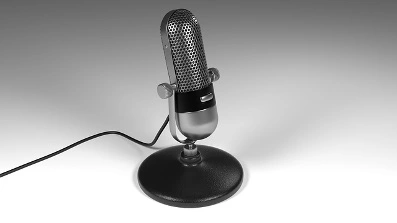A lot of people think that microphones are the only equipment needed for a show or performance. However, they don’t realize that there are certain pieces of gear that need to be used in order to get the best sound quality possible. For example, mixers and amplifiers help amplify the sound coming from your microphone so it can go over a larger audience. If you’re looking for information on how audio equipment works and what other things would be helpful to have at an event where audio is being recorded, then this article is perfect!
Condenser mics
A condenser microphone is a type of microphone that works by converting sound into electrical signals – click here to read my guide on different types of microphones. A condenser has an internal amplifier which makes these microphones relatively more sensitive to low-intensity sounds, compared with other types of microphone. This also means that condensers are among the best mics are often used in recording studios for vocals and acoustic instruments because they usually capture the complete frequency range of the instruments.
Condenser microphones require power to function and this means they must be connected to a microphone preamplifier or mixer, unlike dynamic microphones which can work without any other equipment except a cable that is plugged into an output device such as headphones or speakers. Condenser mics also need 48V phantom power from either a microphone preamplifier or mixer. Phantom power supplies the microphone with enough electric current to ensure it is always operational. Most condenser microphones use an XLR connector, but there are also some that can be connected via USB for direct connection to a computer without needing extra equipment like microphone preamplifiers and mixers.
Dynamic Mic
Dynamic microphones pick up sound through the microphone diaphragm and work without needing any external power. They’re incredibly robust, but they still need a few other bits to make sure you get their full potential. You’ll notice that dynamic mics don’t have an on/off switch or volume control; this is because if it’s connected to a microphone cable, it’s already on. However, there are still some things you can do to make sure your dynamic microphone works well in any environment. Firstly, always use the right type of microphone for its intended purpose; if you need a mic that will stand up to constant movement and won’t pick up much unwanted noise, then choose a dynamic microphone.
However, if you need something that is sensitive to high frequencies and produces a clear sound with less background noise then choose an unidirectional microphone instead. If your dynamic microphone doesn’t come with any other equipment, most microphones will work fine without additional items such as shock mounts or pop shields – but it’s still worth investing in these; they’ll make sure you get the best sound possible. If your microphone doesn’t come with a stand then it’s worth buying one; there are plenty of affordable microphone stands available that will work just as well as more expensive models.
Ribbon mics
Ribbon microphones work by using a thin metal ribbon that is suspended between two magnets. They usually require phantom power to operate, and the microphone’s output level will also depend on how close you are to it as well as the gain setting of your microphone pre-amp. Ribbon mics tend to be fragile so they don’t really need extra equipment such as microphone stands or pop shields, but you should still try and buy a microphone stand if possible. If your ribbon microphone doesn’t come with any other equipment then it’s worth investing in shock mounts and microphone cables too; they’ll help you get the best sound possible from your microphone.

Phantom power
Phantom power (P48 or + 48V) is a DC voltage of 48V +/- 4V (professionally). P48 is provided by mic output preamps and works with balanced audio lines. Some vintage ribbon speakers might be damaged as a result of phantom power or by abrupt disconnection of the microphone from phantom power during the synchronization. Some mics will perform at any phantom power (11 V to 48 V) Other mics will perform below power as the power supply is inadequate. Not all phantom power products output the same full +48 V Thus it is important to use reliable P48 sources. You might want to read my post on what is phantom power.
All mics are active condensers. Other mics have internal preamps to work as dynamic mics. An active microphone needs no power when it is tapped to operate properly. Dynamic microphones are passive because they are operating through electromagnetic induction which is not requiring current. Mics without external preamps FET, JFET or vacuum tubes are likely passive. All condensers microphones are active and the vast majority of dynamic microphones are passive.
Audio interfaces
A microphone doesn’t need an audio interface to work properly, but it’s still worth investing in one. Audio interfaces help you get the best sound possible from your microphone; they’ll boost microphone levels and will stop any interference that would otherwise cause white noise or distortion. Most microphones come with a headphone jack so you can hear what’s being recorded, but if your microphone doesn’t come with this then it’s worth investing in an audio interface that has one. It’s also worthwhile to check whether you need phantom power or not; some microphones don’t require it but others do – and the only way you’ll know is by checking its specifications first. If all else fails then try using a microphone pre-amp; it’s a good way of boosting microphone levels without causing any noise or signal interference – find out why your mic may be picking up everything.
Speakers
Mics don’t need speakers to make them work. You can record vocals and other sound effects for songs or podcasts without a microphone that comes with built-in speakers. Instead, you can just use headphones as an alternative option. Mics are designed specifically so they pick up on sounds from the environment around them, whether it be your voice or a guitar. You may want to read more about how to connect a mic to a loudspeaker.
What do USB Mics require?
Active USB mics are designed to draw maximum power from the +5V DC pin 1 of the USB port. A +5 volt charge is practically always used exclusively to power the analog to digital converter on the USB mic or its JFET mic preamp/impedance converter. USB microphones need power for their analog to digital converters and for their JFet for any condensing mic. This power is provided through pin 1 that is utilized by any connecting PC or the laptop used to power the microphone’s Preamp convenience. The Blue Yeti is a very good USB mic that can be plugged straight into a computer and is popular with podcasters and Youtubers.

Wireless mics
Not really, but they do need to be connected to a microphone transmitter.
Wireless microphones work in the same way as a microphone you would put in your hand.
A wireless microphone is just an amplified microphone that is very small and lightweight, so it can be worn on clothing or attached to someone’s belt with a clip. You might also want to read my other post on the best wireless church microphones.
The microphone picks up sound from its environment but does not pick up any static noise because there are work by sending radio waves that are then picked up my a receiver connected to the speaker’s microphone. However, microphones themselves do not have their own power source they need an external input of energy in order for them to function properly which is why wireless mics need microphone transmitters or RF receivers depending on what kind of microphone and transmitter you have. The audio signal is transmitted by radio waves using microphone transmitters, which usually need to be plugged into the microphone itself.
Shotgun mics
Although mic placement is important, it ultimately does not need any equipment to work. A shotgun mic can still pick up on speech and sounds even without the use of other devices. If you would like to enhance its sound quality, however, there are some things that will help out. For example, if your microphone has a windscreen over it (pop filter), then that will prevent the microphone from picking up any wind noise. Another device you can purchase is a shock mount or boom arm which mounts your microphone to a stand and minimizes movement, so there won’t be as much vibration and rumbling sounds coming through.

Leave a Reply